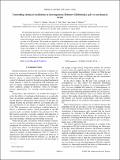Controlling chemical oscillations in heterogeneous Belousov-Zhabotinsky gels via mechanical strain
Author(s)
Yashin, Victor V.; Van Vliet, Krystyn J.; Balazs, Anna C.
DownloadYashin-2009-Controlling chemical.pdf (584.4Kb)
PUBLISHER_POLICY
Publisher Policy
Article is made available in accordance with the publisher's policy and may be subject to US copyright law. Please refer to the publisher's site for terms of use.
Terms of use
Metadata
Show full item recordAbstract
We performed theoretical and computational studies to determine the effect of an applied mechanical strain on the dynamic behavior of heterogeneous polymer gels undergoing the oscillatory Belousov-Zhabotinsky (BZ) reaction. In these spatially heterogeneous gels, the catalyst for the reaction is localized in specific patches within the polymer network and the BZ reaction only occurs within these catalyst-containing patches, which we refer to as BZ patches. We focused on a model for a one-dimensional system, and further assumed that the BZ reaction did not affect the degree of swelling within the gel. For gels having one and two BZ patches, we found that a tensile or compressive strain could induce transitions between the oscillatory and nonoscillatory, steady-state regimes of the system. For certain values of the BZ stoichiometric parameter f, these transitions could exhibit a hysteresis. In systems having two oscillating BZ patches, an applied strain could cause a switching between the in-phase and out-of-phase synchronization of the oscillations. The ability to controllably alter the dynamic behavior of BZ gels through mechanical deformations opens up the possibility of using these materials in the design of chemo-mechanical sensors.
Date issued
2009-04Department
Massachusetts Institute of Technology. Department of Materials Science and EngineeringJournal
Physical Review E
Publisher
American Physical Society
Citation
Yashin, Victor V., Krystyn J. Van Vliet, and Anna C. Balazs. “Controlling chemical oscillations in heterogeneous Belousov-Zhabotinsky gels via mechanical strain.” Physical Review E 79.4 (2009): 046214. (C) 2010 The American Physical Society.
Version: Final published version
ISSN
1550-2376
1539-3755